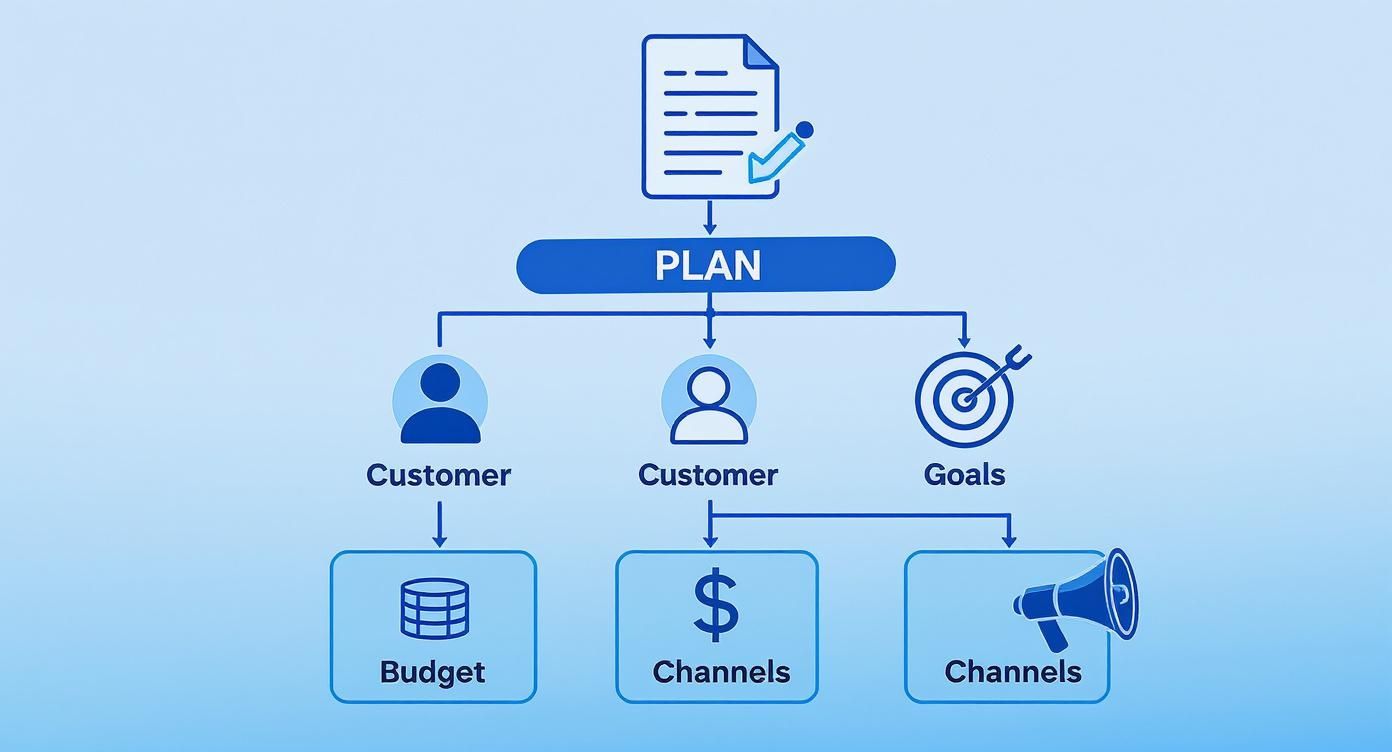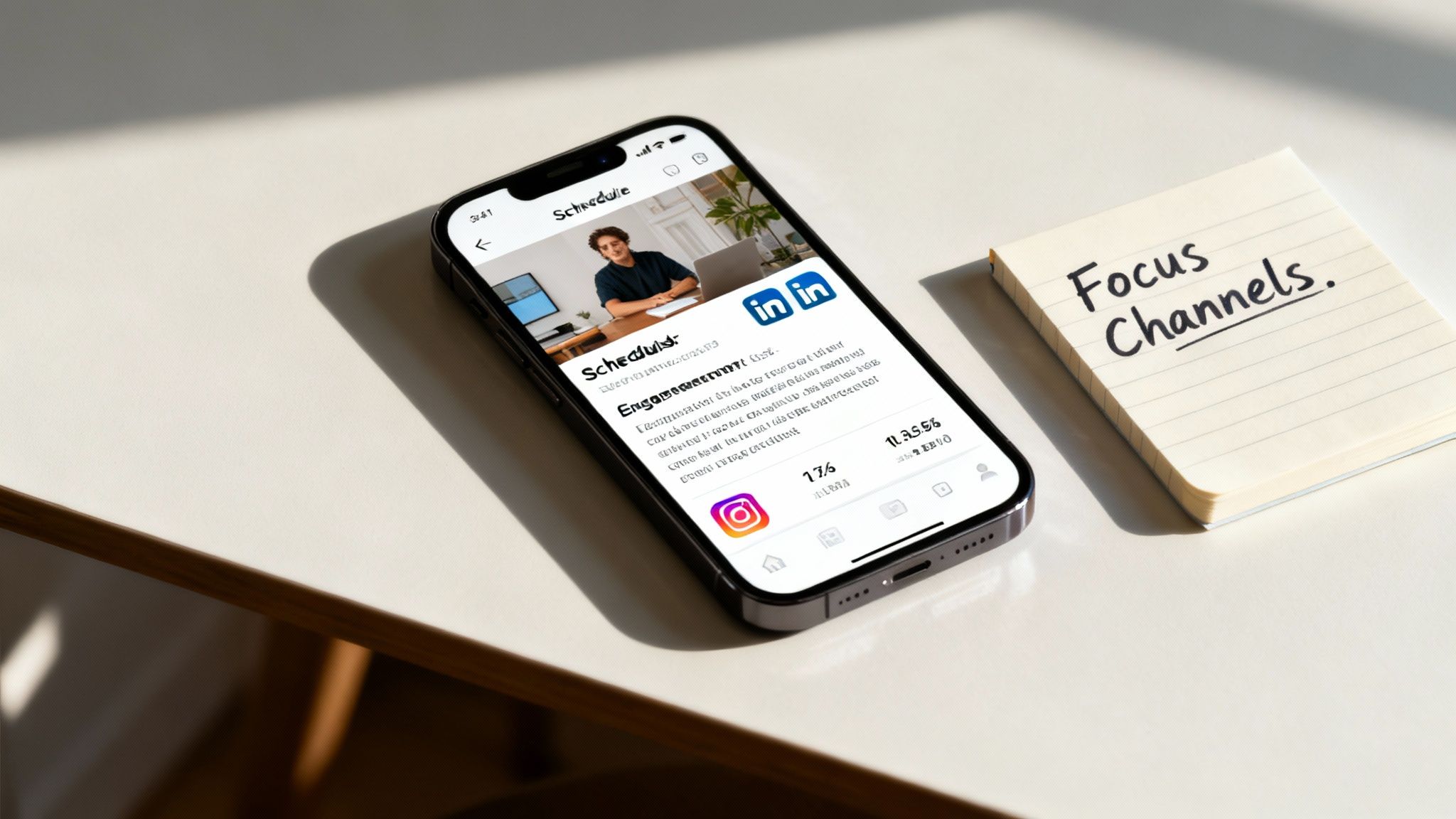Trying to start a business without a solid plan is like setting sail without a map or a compass. You might be moving, but you have no idea if you're heading in the right direction. When it comes to digital marketing for startups, you don't need a 50-page document full of theories. What you need is a simple, actionable framework that guides every single decision, ensuring every dollar and every minute you spend is a deliberate step forward.
Build Your Foundation with a Lean Marketing Plan
I’ve seen it time and time again: one of the biggest mistakes new businesses make is jumping straight into tactics. It’s so tempting to start running ads or blasting social media posts right away. But without a solid foundation, those efforts almost always end in wasted money and frustration.
A lean marketing plan is your strategic compass. It forces you to get crystal clear on the fundamentals before you spend a dime, moving you from guessing what might work to knowing what should work. It's about being purposeful.
Define Your Customer and Your Goals
Before you can sell a thing, you have to know exactly who you're selling to. This isn't a "nice-to-have"; it's a must. When you can paint a picture of your ideal customer—their biggest headaches, where they hang out online, what makes them tick—your marketing message suddenly becomes a thousand times more effective. If you're new to this, a great place to start is learning how to create buyer personas that will shape all your content and targeting.
The other half of the equation is setting goals that actually mean something. "Get more sales" is a wish, not a goal. We need to get specific with SMART goals: Specific, Measurable, Achievable, Relevant, and Time-bound.
- Specific: "Increase qualified leads from our website by 20% in Q3."
- Measurable: "Achieve a 5% conversion rate on our new product landing page."
- Relevant: "Grow our email list to 500 subscribers to support our direct sales efforts."
This diagram really nails the core components you need for a solid marketing foundation.

As you can see, it all flows from that initial plan. Your plan informs your understanding of customers and goals, which then dictates where you put your money and which channels you use.
A well-defined plan is the difference between marketing that feels like a series of random activities and marketing that functions as a predictable engine for growth.
To help you get started on the right foot, I've put together a quick checklist of the foundational marketing activities every new startup should tackle.
Startup Digital Marketing Quickstart Checklist
| Strategy | Focus Area | Key Action |
|---|---|---|
| Market Research | Understand Your Customer | Create 1-2 detailed buyer personas. |
| Goal Setting | Establish Benchmarks | Define 3-5 SMART goals for the next 90 days. |
| Website & SEO | Build Online Presence | Launch a simple, mobile-friendly website and set up Google Analytics. |
| Local Presence | Capture Local Search | Create and optimize your Google Business Profile listing. |
| Content | Demonstrate Expertise | Write and publish your first 2-3 blog posts answering customer questions. |
| Social Media | Engage Your Audience | Choose one social platform where your customers are active and post consistently. |
This checklist isn't about doing everything at once. It's about focusing on the high-impact actions that lay the groundwork for everything else.
With your ideal customer in mind and clear goals defined, you’re finally ready to think about your budget and pick the marketing channels that will give you the biggest bang for your buck. This foundational work stops you from spreading your limited resources too thin and helps you zero in on what will actually move the needle in these critical early days.
Dominate Search with Smart SEO for Startups
For any new business, showing up on Google isn’t just a nice-to-have; it's a lifeline. Think about it: when someone needs a solution to a problem, their first instinct is to search online. Search Engine Optimization (SEO) is how you make sure your startup is the answer they find. It’s all about earning free, highly relevant traffic that grows over time.
Imagine SEO as building a digital storefront on the busiest street in the world. Instead of paying sky-high rent for a prime spot (the way you do with ads), you earn your position by being the most helpful, trustworthy, and relevant shop for what people are looking for. This is what makes SEO so powerful for startups—it builds a real, sustainable asset for your business.

While the term "SEO" might sound intimidating, the core idea is straightforward. You figure out what your customers are searching for, create the best content to answer their questions, and make sure your website is easy for search engines to crawl and understand. If you're new to this, our complete guide explaining what is search engine optimization is a great place to start.
The Quick Win: Your Google Business Profile
For most startups, especially those serving a local area, your Google Business Profile (GBP) is the single most valuable SEO tool you have. It’s that handy info box that pops up in Google Maps and local search results, showing your address, hours, photos, and reviews. Ignoring it is like owning a shop but forgetting to put a sign on the door.
Getting your GBP in top shape is a non-negotiable first step. This is your chance to grab the attention of potential customers right in your neighborhood—people who are often ready to make a purchase.
Here’s what you need to do right away:
- Complete Every Single Section: Don’t cut corners. Fill out every field available, from services and products to accessibility attributes. The more details you give Google, the better it understands what you do.
- Upload High-Quality Photos: This is huge. A profile packed with real photos of your space, your team, and your products builds instant trust.
- Actively Chase Reviews: Customer reviews are a massive ranking signal. Encourage your happy customers to leave feedback, and make sure you respond professionally to every review, good or bad.
- Use Google Posts: Think of this as a mini-blog for your business. Share regular updates, special offers, and news to show Google (and customers) that you're active and engaged.
Your Google Business Profile is your digital welcome mat. A fully optimized profile with great photos and glowing reviews can immediately increase calls, website clicks, and foot traffic.
Building Long-Term Authority
While your GBP provides a fantastic initial boost, true search dominance requires a long-term vision. It's all about methodically proving to search engines that you are a credible authority in your niche. This is where creating genuinely helpful content comes into play.
By publishing blog posts, guides, and articles that solve your customers' biggest problems, you start attracting organic traffic and earning valuable backlinks from other websites. You can dive deeper into these tactics with comprehensive guides on SEO strategies specifically designed for small businesses.
Investing in SEO isn't just a trend; it's a fundamental business strategy. Today, 92% of marketers plan to maintain or increase their SEO investment because they know it works. In fact, a staggering 91% report that SEO has directly improved their website's performance and helped them hit their business goals.
For startups, visibility is credibility. And with local queries making up 46% of all Google searches, a killer Google Business Profile is more critical than ever. Consider this: profiles with over 100 images get 1,065% more clicks. That alone shows how much rich, visual content can attract local customers.
Create Content That Builds a Loyal Audience
Let's be clear: content marketing isn't about churning out blog posts just to have something new on your site. It's about becoming the one-stop shop for expertise in your niche—the name people think of first when they have a problem you can solve. For any startup, this is a game-changer. It’s how you build a real asset that pulls in traffic and leads long after you’ve stopped paying for ads.
I like to think of it this way: paid advertising is like renting an apartment. The second you stop paying, you're out on the street. Content is like building your own house. It's a lot of work upfront, but once it's built, it's yours to keep, and it provides value for years.
Uncover Your Audience's Real Problems
The secret to killer content isn't a secret at all: stop guessing what people want and start listening. Your job is to find their most nagging problems and solve them better and more clearly than anyone else. Put the sales pitch on the back burner and just focus on being genuinely helpful.
You don't need fancy, expensive software to figure this out. The best insights are usually hiding in plain sight.
- Read Online Reviews: Check out the reviews for your competitors. What are people constantly complaining about? What do they absolutely love? Every one of those comments is a potential content idea.
- Browse Forums and Social Groups: Dive into Reddit, Quora, or niche Facebook groups where your ideal customers hang out. Look for the questions that pop up over and over again.
- Talk to Your First Customers: If you've got even a few customers, just ask them. What was the biggest headache that led them to find you? What were they unsure about before they decided to give you a try?
Every single one of these pain points can be turned into a practical guide, a simple checklist, or an in-depth article. This way, you know you’re creating something people are actually looking for, not just adding to the noise.
Focus on Pillar Content and Repurpose Everything
As a startup, you don't have the time or the team to create something new every single day. The trick is to work smarter, not harder. Go all-in on creating a handful of "pillar" content pieces. These are your massive, comprehensive guides on the most important topics in your industry.
Think of something like "The Ultimate Guide to…" or "Everything a Beginner Needs to Know About…" These are deep dives that cover a big topic from top to bottom.
Pillar content is your home base for a specific topic. Once you have that one massive piece, you can carve it up into dozens of smaller posts, videos, and graphics. It’s all about maximizing your effort.
For example, let's say you write one big guide on "Choosing the Right Coffee Beans for Cold Brew." You can easily spin that one piece into:
- Social Media Posts: Pull out ten different types of beans and give each one its own post.
- Short Video: Film a quick clip showing the visual difference between a light roast and a dark roast for cold brew.
- Email Newsletter: Send your top three bean recommendations to your email list as a bite-sized version of the guide.
- Infographic: Create a simple chart comparing flavor notes, origins, and acidity levels.
This is how a small team can show up consistently across different channels without burning out. To get really good at this, exploring effective content creation strategies will give you a repeatable process for engaging your audience.
Distribute Your Content Where It Matters
Creating something brilliant is only half the job. Now you have to get it in front of the right eyeballs. This is where distribution comes in. It’s how you turn your great content into a magnet for potential customers. Never just hit "publish" and hope people find it.
For every big piece of content you create, run it through a simple distribution checklist.
- Email Your List: Your email subscribers are your biggest fans. They should always be the first to know when you've published something new.
- Share on Social Channels: Take those smaller, repurposed pieces and share them on the one or two social platforms where your audience actually spends their time.
- Engage in Communities: When you see someone in a forum or group ask a question that your content answers perfectly, share the link. Be helpful, not spammy.
- Basic SEO: Make sure your article has a clear title, uses words people are actually searching for, and directly answers a question. This is how you'll start showing up in Google searches over time.
By creating content that truly helps and then making sure people see it, you build the two things that matter most for a startup: trust and authority. That's what turns casual visitors into a loyal audience.
Use Social Media Without Wasting Your Time
For any startup running lean, social media can feel like a black hole. It’s a place where precious time and energy disappear with very little to show for it. The classic mistake? Trying to be everywhere at once, spraying posts across every platform and getting hooked on vanity metrics like likes and follower counts.
A much smarter way is to think of social media as a tool for connection, not just a megaphone. The real goal isn't just to rack up followers; it's to build a genuine community of people who care about what you're doing. This means getting focused and strategic, pouring your energy into the one or two platforms where your ideal customers actually hang out. It’s a fundamental rule for startup marketing: do fewer things, but do them incredibly well.

Find Your People and Go All-In
Stretching yourself thin across five different social platforms is a direct path to burnout and mediocre results. Your first and most important job is to figure out where your audience lives online. And don't just guess that they're all on Instagram; you need to do a little digging.
If you're a B2B software company, your people are probably on LinkedIn, talking shop and making professional connections. If you're a brand selling beautiful, artisanal home goods, your tribe is almost certainly on visual platforms like Instagram or Pinterest. You have to choose your battlefield wisely.
Once you’ve found your primary platform, commit to it. Really commit. Learn its quirks, understand its unwritten rules, and create content that feels native to that space. A deep-dive case study that gets tons of engagement on LinkedIn will almost certainly fall flat as a TikTok video. Every platform has its own language, and when you show you can speak it, you build instant credibility.
Engage Authentically and Build Community
It’s called "social" media for a reason. It’s not just about pushing out content; it’s about starting conversations. Your main job on these platforms is to listen, react, and engage.
Think of your social media account like you're hosting a dinner party. You wouldn't just stand in the corner and shout advertisements at your guests, right? You’d mingle, ask questions, listen to their stories, and make connections. That’s exactly how you build a real community online.
Here are a few practical ways to get those conversations started:
- Ask Open-Ended Questions: Don't just post a picture of your product. Ask your audience how they'd use it or what problem it could solve for them.
- Respond to Every Comment: Someone took the time to write a comment—that’s a gift! Acknowledge them. This simple act makes people feel seen and valued.
- Practice Social Listening: Eavesdrop on conversations happening in your industry. What are people excited about? What are their biggest frustrations? This is free market research that can guide your content and even your product roadmap.
By focusing on real conversations, you stop being a content machine and start building a loyal group of brand advocates—people who trust you and are far more likely to become customers.
Create Platform-Specific Content That Resonates
One-size-fits-all content is a myth. To truly connect, you have to tailor your message to the platform you’re on. This doesn’t mean creating ten different pieces of content from scratch. It’s about adapting your core message to fit the environment.
Here’s a quick guide on how to think about content for the major platforms:
| Platform | Best For… | Content Ideas for Startups |
|---|---|---|
| B2B networking, establishing expertise, and professional updates. | Founder stories, industry insights, company milestones, detailed case studies. | |
| High-quality visuals, brand storytelling, and user-generated content. | Behind-the-scenes videos, product tutorials, customer photos, Reels. | |
| TikTok | Short-form, entertaining, and educational video content. | Quick tips, creative product demos, and jumping on relevant trends (authentically!). |
| Building community, customer service, and targeted local ads. | Event promotions, customer Q&As in a group, sharing helpful blog posts. |
And remember, consistency is always better than frequency. It's far more effective to post three high-quality, engaging pieces of content a week on one platform than it is to post ten mediocre updates across five. Focus your energy where it matters most, and you’ll turn social media from a time-suck into a powerful growth engine for your startup.
Run Smart Ads with a Lean Startup Budget
While organic growth is the marathon, sometimes a startup just needs a quick sprint. Paid advertising on platforms like Google and social media can deliver that burst of speed, getting your brand in front of the right people, right now. The trick is to be surgical with your spending, making every dollar count.
A lot of founders shy away from paid ads, worried they’ll just drain their bank account with nothing to show for it. It's a fair concern. But when done right, paid ads are one of the most reliable ways to get customers in the door. It all comes down to knowing exactly who you're talking to and what you want them to do.

Start Small and Target Sharply
Your first ad campaign shouldn't be a giant, "spray and pray" effort. Think of it more like a small, controlled experiment. The goal here is simple: learn as much as you can while risking as little cash as possible. This mindset is crucial when you're just starting out with paid media.
-
For Google Search Ads: Forget bidding on broad, hyper-competitive keywords like "coffee." Instead, zero in on long-tail keywords that signal someone is ready to buy, like "buy organic whole bean coffee online." People searching for that know exactly what they want.
-
For Social Media Ads: The targeting options are incredibly powerful, so use them. Dig deeper than just age and location. Target users based on their specific interests, online behaviors, or even create a "lookalike audience" modeled after your best existing customers.
This super-specific targeting means your ad only appears in front of people who are genuinely likely to be interested, which massively boosts your odds of getting a click and, ultimately, a customer.
Know Your Campaign Goal
Not all ads have the same job. Before you even think about writing ad copy, you have to be crystal clear on your objective. Are you just trying to get your name out there, or are you trying to drive sales today?
Awareness campaigns are for introducing your brand to new people. Conversion campaigns are laser-focused on getting someone to take a specific action, like making a purchase or signing up for a newsletter. As a startup, your early ad dollars should go almost entirely toward conversion campaigns.
An awareness campaign might look good on paper with lots of eyeballs, but a conversion campaign is what brings in the cash and proves your business can work. You need to see a clear return on what you spend, and that means optimizing for action.
Measure Everything and Optimize Relently
The best thing about digital advertising is the data. You can see precisely how many people saw your ad, how many clicked, and what they did next. This feedback loop is how you separate the campaigns that make you money from the ones that lose it.
The single most important metric to live and die by is your Return On Ad Spend (ROAS). It’s a simple question: for every dollar you put in, how many dollars in sales are you getting back? If your ROAS is positive, you’ve found a profitable way to get customers, and you can start thinking about scaling up.
To improve that ROAS, you have to be constantly testing and tweaking. This usually involves:
- A/B Testing Ad Copy: Run two slightly different versions of an ad—maybe change the headline or the image—to see which one resonates more with your audience.
- Optimizing Landing Pages: The page people land on after clicking your ad must match the ad's promise perfectly and have an obvious call-to-action. Don't make them hunt for the "buy now" button.
- Using Retargeting: This is a big one. Show special ads to people who have already visited your website but left without buying. They're already familiar with you, which makes them much more likely to convert the second time around.
By starting small, targeting with precision, and obsessively tracking your numbers, you can transform paid ads from a scary expense into a predictable engine for growth.
Measure What Matters and Use Smart Automation
Marketing without measurement is just shooting in the dark. You can throw a ton of money and time at different strategies, but if you don't know what's actually bringing in customers, you're just guessing. For a startup, that's not just a waste, it's a massive risk. To get your digital marketing right, you have to track the right things and use smart tools to make your life easier.
Think of your marketing data like the dashboard in your car. You wouldn't drive down the highway without glancing at your speed or fuel gauge, right? In the same way, you can't steer your business toward growth without keeping an eye on the key metrics that show you how your marketing engine is running.
Identify Your Most Important Metrics
Don't get bogged down by every single data point available. When you're just starting out, you only need to be obsessed with a handful of key performance indicators (KPIs) that are directly tied to your revenue. These are the numbers that tell you the real story.
- Customer Acquisition Cost (CAC): This is the big one. How much does it cost you to get one new customer? Simply take your total marketing and sales spend and divide it by the number of new customers you brought in. If you spend $500 on ads and get 10 new customers, your CAC is $50. You absolutely have to know this number.
- Conversion Rate: This is the percentage of people who take the action you want them to, whether it's buying a product, filling out a form, or signing up for your newsletter. A low conversion rate is a huge red flag that something is wrong with your website, your messaging, or your offer itself.
- Website Traffic: This tells you how many people are actually finding you online. A free tool like Google Analytics is perfect for this. It shows you where your visitors come from, like Google searches, social media, or paid ads, so you can focus your energy on the channels that are already working.
Measuring these core metrics is the first step toward building a predictable growth machine. It moves you from hoping for success to engineering it with data-driven decisions.
Embrace Smart Automation and AI
For a small startup team, time is your most precious asset. This is where automation and artificial intelligence (AI) become your unfair advantage. These aren't just buzzwords for big corporations; they are real, accessible tools you can start using today to get more done with a smaller team.
Startups are quickly jumping on AI to make their marketing efforts more efficient. In fact, nearly 20% of startups are already planning to use AI agents for marketing automation. Why? Because it lets small teams punch way above their weight and compete with bigger players. With almost half of all marketers now getting the hang of AI, these tools are becoming a standard part of the playbook. You can find more data on how startups are using tech in recent industry reports.
Here are a few practical ways you can put automation and AI to work right now:
- Email Marketing Automation: Set up a "welcome" series that automatically sends to new subscribers or an email sequence that follows up with people who abandon their shopping cart.
- Social Media Scheduling: Use a tool to plan out your social media posts for the week or month all at once. This can save you hours of daily work.
- AI-Powered Content Aids: Feeling stuck? Use an AI tool to brainstorm blog post ideas, write a first draft of ad copy, or even summarize a long article into a few bullet points for Twitter.
By tracking what truly matters and letting smart tools handle the repetitive tasks, you free up yourself and your team to focus on what humans do best: strategy, creativity, and building relationships. That’s what will really make your startup stand out.
Your Startup Marketing Questions, Answered
Getting into digital marketing for the first time can feel like you're trying to drink from a firehose. There's a lot to learn. We get it. Here are some of the most common questions we hear from founders, broken down with simple, straightforward answers to help you get started.
How Much Should a Startup Spend on Digital Marketing?
There’s no one-size-fits-all answer here, but a good starting point for a new startup is to allocate 10-20% of your projected revenue to marketing. If you don't have revenue yet, you'll have to base your budget on your operational costs and whatever funding you've secured.
The key is to start small. Test everything and track what comes back from each channel. Once you find a strategy that’s clearly working, that's your green light to double down and invest more. Always try to max out low-cost, high-impact activities like SEO and content first before you start pouring money into ads.
Which Digital Marketing Strategy Should I Focus on First?
For most new businesses, the best place to start is with a one-two punch: Search Engine Optimization (SEO) and Content Marketing. These two are a perfect pair for building a real, long-term asset for your company.
By creating genuinely useful content that solves your audience's problems, you build trust and start showing up in Google searches. While you're at it, set up and completely fill out your Google Business Profile. This is a must for grabbing any local search traffic. These foundational steps don't cost a fortune and pay you back over and over again down the road.
So many startups make the mistake of jumping straight into paid ads before they have any organic presence. Your SEO and content are the foundation that makes every other marketing effort, especially paid ads, work better and cost less.
How Long Does It Take to See Results?
This really depends on the channel you’re using. Setting the right expectations from the get-go is critical.
- Paid Advertising: Things like Google Ads or social media campaigns can bring in traffic almost immediately. The catch? The moment you turn off the spend, the traffic disappears.
- Organic Marketing: SEO and content marketing are the long game. It often takes 3-6 months, sometimes longer, to see a meaningful lift in search rankings and the organic traffic that comes with it.
The smartest move is to run a balanced playbook. Use a small, targeted ad campaign for some quick wins while you consistently build your long-term organic engine in the background.
What Are the Most Important Marketing Metrics to Track?
It’s incredibly easy to get buried in data and lose focus. In the early days, you need to be obsessed with just a few core numbers that tell you if the business is actually working.
- Website Traffic: Are people finding you? This is the most basic sign that your awareness efforts are paying off.
- Conversion Rate: Of all the people who visit, what percentage actually takes the action you want them to (like buying something or signing up)?
- Customer Acquisition Cost (CAC): How much does it cost, on average, to get a single new customer? This is probably the most important number for any startup to know.
If you keep a close eye on these three, you'll know whether your marketing dollars are being spent wisely and if you're building a business that can last.
At Digital Lotus Marketing, we specialize in creating powerful digital marketing strategies for startups that drive real growth. Contact us today to build your custom marketing plan.





